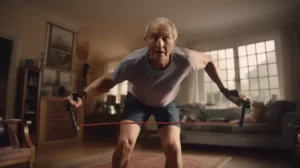Did you know that sitting for more than three hours a day can lead to a shorter life expectancy? Sitting down all day, or leading a sedentary lifestyle, has substantial consequences on your overall health. As researchers unveil the negative effects of this “couch-potato” lifestyle, it’s time to learn more and take action. In this article, we dive deeper into the importance of staying active throughout the day, and how sitting less can add years to your life.
The Research: Sitting Less Equals Longer Life Expectancy
A study conducted at the Pennington Biomedical Research Center in Baton Rouge, Louisiana, examined the effects of sedentary habits on life expectancy. The research indicated that if people sat for less than three hours a day, they could potentially live two years longer. Furthermore, reducing daily TV viewing to less than two hours could add 1.38 years to your life.
These findings are eye-opening and stress the importance of living an active lifestyle. “So, instead of living to 78.5, we would be expected to live to 80.5 years old,” says researcher Peter Katzmarzyk. “That’s a really big deal.”
Sitting and Health Deterioration: Some Scary Stats
Spending more hours sitting each day can lead to significant health problems. Excess sitting is linked to obesity, type 2 diabetes, cardiovascular disease, and even some types of cancer. Here are some stats that might make you want to stand up and take notice:
- A study by the American Cancer Society found that sitting for six or more hours a day increased the risk of premature death from all causes by 19%, compared to sitting for less than three hours a day.
- According to the World Health Organization, physical inactivity is the fourth leading cause of death globally, responsible for 3.2 million deaths annually.
- Research from Harvard Medical School ties too much sitting to an increased risk of heart disease, diabetes, and premature death.
- Excessive sitting can also lead to muscle degeneration, poor posture, and an increased risk of developing deep vein thrombosis (DVT), a dangerous blood clot in the legs that can travel to the lungs and become life-threatening.
Simple Strategies to Sit Less
It’s time to make a conscious effort to sit less and be more active throughout your day. Here are some simple strategies to help you incorporate more movement into your daily routine:
- Set a timer: Set an alarm or timer to remind you to stand up and move around every 20-30 minutes. This will help reduce the negative effects of prolonged sitting and encourage you to stay active throughout the day.
- Walk during breaks: Instead of sitting during your lunch break, go for a walk outside. Not only will this help you burn calories, but the fresh air and natural sunlight will improve your mood and productivity.
- Standing desk: Consider investing in a standing desk or a desk converter that allows you to easily switch between sitting and standing throughout the day.
- Walking meetings: Instead of sitting in a conference room, suggest a walking meeting to discuss business matters with colleagues. This will promote physical activity and encourage collaboration among team members.
- Stretches and exercises at your desk: Perform simple stretches and exercises at your desk to break up periods of sitting and keep your muscles active. This can include seated leg lifts, chair squats, and shoulder shrugs.
- Take the stairs: Choose to take the stairs instead of the elevator when possible. This will not only be beneficial for your cardiovascular health but also help to strengthen and tone your leg muscles.
Conclusion
It’s clear that too much sitting can lead to serious health issues and a shorter life expectancy. Break the cycle of a sedentary lifestyle and make a conscious effort to move more throughout your day. By incorporating the strategies above and decreasing the amount of time you spend sitting, you can improve your overall health and potentially add years to your life. So, stand up, stretch out, and start enjoying the benefits of a more active lifestyle.


![8 Simple Tips for a Longer, Happier Life [See Them Now]](https://naturalhealthreserve.com/wp-content/uploads/2024/01/8-healthy-tips-live-longer-slideshow-300x168.webp)
